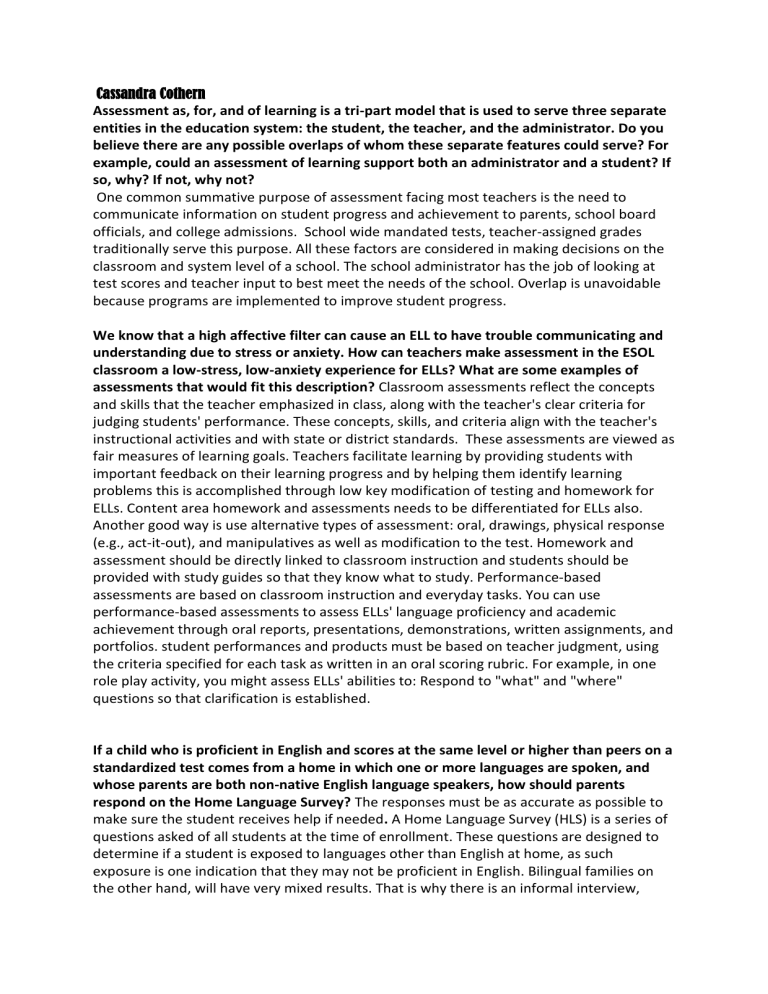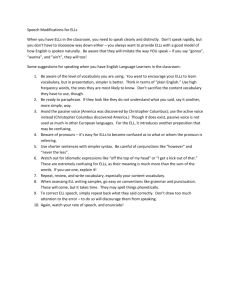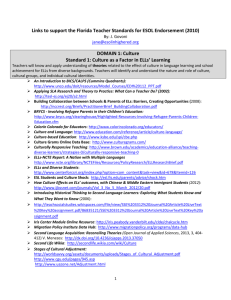ELL Assessment Strategies: Equity, Collaboration, & Language
advertisement

Cassandra Cothern Assessment as, for, and of learning is a tri-part model that is used to serve three separate entities in the education system: the student, the teacher, and the administrator. Do you believe there are any possible overlaps of whom these separate features could serve? For example, could an assessment of learning support both an administrator and a student? If so, why? If not, why not? One common summative purpose of assessment facing most teachers is the need to communicate information on student progress and achievement to parents, school board officials, and college admissions. School wide mandated tests, teacher-assigned grades traditionally serve this purpose. All these factors are considered in making decisions on the classroom and system level of a school. The school administrator has the job of looking at test scores and teacher input to best meet the needs of the school. Overlap is unavoidable because programs are implemented to improve student progress. We know that a high affective filter can cause an ELL to have trouble communicating and understanding due to stress or anxiety. How can teachers make assessment in the ESOL classroom a low-stress, low-anxiety experience for ELLs? What are some examples of assessments that would fit this description? Classroom assessments reflect the concepts and skills that the teacher emphasized in class, along with the teacher's clear criteria for judging students' performance. These concepts, skills, and criteria align with the teacher's instructional activities and with state or district standards. These assessments are viewed as fair measures of learning goals. Teachers facilitate learning by providing students with important feedback on their learning progress and by helping them identify learning problems this is accomplished through low key modification of testing and homework for ELLs. Content area homework and assessments needs to be differentiated for ELLs also. Another good way is use alternative types of assessment: oral, drawings, physical response (e.g., act-it-out), and manipulatives as well as modification to the test. Homework and assessment should be directly linked to classroom instruction and students should be provided with study guides so that they know what to study. Performance-based assessments are based on classroom instruction and everyday tasks. You can use performance-based assessments to assess ELLs' language proficiency and academic achievement through oral reports, presentations, demonstrations, written assignments, and portfolios. student performances and products must be based on teacher judgment, using the criteria specified for each task as written in an oral scoring rubric. For example, in one role play activity, you might assess ELLs' abilities to: Respond to "what" and "where" questions so that clarification is established. If a child who is proficient in English and scores at the same level or higher than peers on a standardized test comes from a home in which one or more languages are spoken, and whose parents are both non-native English language speakers, how should parents respond on the Home Language Survey? The responses must be as accurate as possible to make sure the student receives help if needed. A Home Language Survey (HLS) is a series of questions asked of all students at the time of enrollment. These questions are designed to determine if a student is exposed to languages other than English at home, as such exposure is one indication that they may not be proficient in English. Bilingual families on the other hand, will have very mixed results. That is why there is an informal interview, done by a specialist who can determine whether or not the child demonstrates the linguistic signs of being in the process of the development of English as a second language. This informal interview is done with all students whose form indicates a language other than English used in the home, unless it is not indicated, that it is clear the student is not an ELL. If there is still doubt about the child's needs after this, the protocol is to call the home and have a conversation with the parents and get input from the teachers In which ways can subject area teachers collaborate with each other and with ESOL teachers in order to achieve the language proficiency/development standards outlined by WIDA? WIDA’s Action 14 from their Essential Actions: A Handbook for Implementing WIDA’s Framework for English Language Development Standards (Gottlieb, 2013) encourages collaboration between content and English language teachers (ELTs). Gottlieb writes that, “Teachers have to share responsibility, coordinate instruction, and engage in a cooperative process to reach common goals for their students” (2013, p. 64). Cooperation consist of two parts: co-planning and co-teaching to ensure that ELs learn content in tandem with developing language skills (Echecarria, Vogt, & Short, 2008). Content alignment means that the content teacher and ELT cover the same topic but in different ways. It involves some inperson co-planning to align the content-specific topic with language instruction. collaboration involves the content teacher and ELT co-planning the learning experiences. It requires more in-person planning, which can be meaning meeting on an ongoing basis. While it requires more time, scaffolding results in better academic gains for ELs due to the depth and breadth of the collaboration. Modifying assessments is the first step to establishing this positive relationship and helping colleagues appreciate the importance of t collaboration. Some helpful modifications to assessments are: adding images, diagrams, graphs providing a content vocabulary word bank without defining the vocabulary words using sentence frames intentionally sequencing questions from easiest to most difficult allowing for multiple choice. To begin, the content teacher designs the initial assessment because she is most familiar with the content. Then a discussion is held on ways to scaffold the assessment. Describe the difference between equality and equity as it relates to assessing and educating English Language Learners. How do standards and assessments play into this debate? Gottlieb mentions that “while standards are the anchor for curriculum, instruction, and assessment, academic language is the unifying thread and crosswalk among them.” Discuss how and why academic language serves as this ‘thread.’ it's important that we ensure a fair assessment for ELLs. When we assess this population, we must remember to separate language skills from content skills. Some of these language skills include vocabulary, comprehension, phonology, grammar (syntax), and meaning (semantics). Content assessment focuses on whether or not the student was able to grasp the subject matter. Duverger (2005) suggests that "another way of disentangling the effects of language proficiency on content proficiency is to have a double scale of criteria: Equitable Accommodations Allow students to use a dictionary and/or thesaurus and give students extra time. Also provide information, instructions, and content through an alternative method, such as visual or audio. This allows ELLs to connect with the content not just through words but also through other senses. Encourage the use of other methods as well if they're creating the content. For example, multimedia can help them tell a story or write a response. By Allowing translations the teacher can assess student performance more thouroughly. Explain why discussion, explanation, argumentation and recount of a subject might allow ELL students to experience greater success in both content mastery and language proficiency in core subject areas. What strategies can be incorporated with in this breakdown of a standard to further engage ELL students? The Common Core State Standards and the Next Generation Science Standards sets the guidelines for the types of language that the framework standards expect of students. WIDA found that the type of language used most often in academic and business settings were recount, explain, argue, and discuss. They are grouped into four forms of languages into what they call Key Uses because they are recognized as the “keys” to academic success. A recount structure is used to narrate events or identify facts. If a teacher wants students to narrate a story or experience, then he will have to reinforce the importance of correctly sequencing events. An example from history class might be to recount the events that occurred after Christopher Columbus made contact with the Indians. One easy framework when teaching narrative recount is having students identify the “W” Questions – what, when, where, and how. An explain structure clarifies why or how a phenomenon occurs. It emphasizes the connections between events or the cause-effect relationship. For example, the drama teacher might want students to explain how a play is produced. The diagram should have boxes that capture the factors involved in running the play such as lighting, staging, music, and custom design. In an academic context, to argue means to create a claim and provide justifications to support it. An example might come science class where the teacher asks students to argue whether climate change is a real problem. For some ELs, their cultural expectations might not permit people to ask questions, provide opinions, offer inferences, or assert claims. For example, in class after a video instruct students to provide an opinion in the form of a Quick Write. This will give all students an opportunity to express their views. In the content area of science, how might you use real world materials to assess students’ knowledge of the content? How do viewing real world experiences (experiments, science in nature, etc.) facilitate learning for ELLs? Real-world connections draw from, or upon, actual objects, events, experiences and situations to effectively address a concept, problem or issue. It involves learning allows students to actually experience or practice concepts and skills. When possible have the learning, process include the making of something useful. (to eat- biology students can make a water tunnel, Real world activities will allow students to use hands on activities to see how things actually work. The water tunnel would demonstrate the effects of gravity on water pressure. Which teaching and classroom management approaches would you use to lower the affective filter for ELL students who were directly impacted by a historical period that you are teaching in a social studies class? First explore scenarios in which this could be an issue, describe why it would be an issue, and discuss how you would adhere to the state standards, yet teach the information with multiple perspectives to consider. There are many issues that arise within the context of studying academic disciplines. For example, the following questions might arise: Who or what caused the explosion of the battleship Maine? Does television contribute to violence in society? How can the forces of racism be controlled? Does capital punishment deter crime? What would be the economic effects of a flat rate tax? How did anti-war demonstrations influence policymakers during the Vietnam era? Why did Hitler turn to a policy of genocide? Could be a touchy subject. Disciplined inquiry into these questions typically follows the social scientific method or the historical method. These methods involve gathering data relevant to the question, assessing the soundness or validity of these data, and formulating an answer to the central question that seems best supported by relevant data. The concept of an answer "best supported" by evidence is a critical one because we assume that well-informed people may continue to disagree on the best answer. What is important is that the disagreements entail debates about the quality and relevance of evidence as well as the logic used in coming to a particular conclusion. The students' development of enhanced capacities in analysis and data-based argumentation is listed in the common core standards. The teacher is primarily concerned with creating a classroom atmosphere in which students feel free to express whatever views they may hold, to pursue lines of inquiry or argument that make most sense to them as individuals, and to arrive at conclusions with little or no challenge from the teacher. What are some ways teachers can create rich instruction using strategies to develop oral language and listening comprehension? Oral language provides the foundation for literacy development. English language learners (ELLs) need daily opportunities to learn and practice oral English in order for their literacy skills to flourish. ELLs learn English primarily by listening to language in use around them, while using context to figure out what the spoken words mean. This language serves as the input or data that learners internalize and use to express their own meanings in their interactions with others. Strategies Teachers include listening as an integral part of reading and writing instruction. There are good strategies that involve students as active and engaged listeners such as guiding students to identify literary elements as they read aloud, listen to, and discuss books together, provide opportunities for students to discuss insights from their reading with each other by using group discussion or cooperative learning groups and model and explain textto-world connections for the students. Daily sharing is important to stimulate acquired knowledge. Teachers provide ample opportunities for students to talk about familiar topics and then demonstrate to students how talking better enables them to write. Teachers should have regular conversations with individual students about their writing to help them improve in areas that may be a problem. Teachers can model how to verbalize understandings and questions about readings and then provide opportunities for students to practice these comprehension strategies. It is important to consider that many ELLs go through a "silent period," during which they listen and observe more than they speak. ELLs may speak at first in single words or short phrases. They may speak fluently when using greetings and other basic phrases in routine interpersonal situations, but speak haltingly when constructing English sentences to express more complex ideas. Effective teachers are aware that ELLs who are quiet in class may be hard at work listening and comprehending. Teachers also know that ELLs may take longer to answer a question or volunteer a comment, because they need more time to process meaning and formulate an appropriate response. How could a teacher manage a class activity involving digital literacy where some students are very familiar with technology and others are not familiar at all? What could the teacher do to bridge this knowledge and experience gap? First the teacher should use the direct approach in the use of digital instruments such as computers. A smart board is useful because the students will be exposed to a visual image. Introducing vocabulary is important. The teacher needs to guide students through the platform that will be utilized in the classroom. I usually allow students to practice and those that are already tech savvy are assigned to be classroom helpers. Gottlieb cites research (2009, Newman) that demonstrates a relationship between the quality of cognitive engagement in tasks and students’ academic achievement and found that “all students, regardless of social or ethnic background, achieve at higher levels when they participate in an intellectually challenging curriculum, and equity gaps diminish as a result of engagement in such curricula”. We know that classroom assessments can show what you know. Does the term “assessment” always mean “test” in the traditional sense of everyone receiving the same questions at the same time using the same grading scale? Describe alternate means of gathering data to show student growth. Informal assessments are usually use as alternative indicators of student progress. Tests and quizzes - this is the typical way students are evaluated for their acquisition of knowledge, usually consisting of elements such as multiple-choice questions, true and false questions, short-answer questions, fill-in-the-blank questions, and so on. Grading - this is how teachers normally assign value to a student's work but it doesn’t have to be a real grade because it can be used to diagnose a student’s performance. There are allot of alternatives out there for example: Portfolios - this is an assessment tool that is great for helping students, as well as their teachers and parents, to see their progress over time. Students collect completed assignments in a single folder or portfolio. By looking at all of their work over the course of time, they can see how they have improved and/or where they need more work. Written samples - this entails any type of written work that students create to show their comprehension of material. It can take many forms, the essay being the most common. Project-based assignments - this type of assignment is usually quite extensive and allows the student to show off his or her accomplishments in a variety of ways. The student creates a project of some sort that illustrates his understanding of what he has learned over time.



